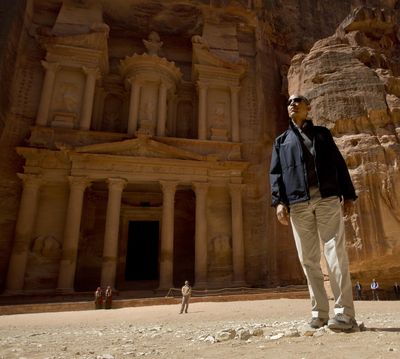Obama takes in sights at end of Mideast trip
Four-day visit saw modest successes

PETRA, Jordan – Content that he laid the groundwork for possible improvements in the Middle East, President Barack Obama played tourist Saturday, gazing at the wonder of the ancient city of Petra on his last stop of a four-day trip to the Mideast.
As he did, he left behind some signs of change in the region, most notably a potential rapprochement between Israel and Turkey.
He also left a push to restart Israeli-Palestinian peace talks with Secretary of State John Kerry staying behind to huddle with the principals, and a much warmer relationship with Israeli Prime Minister Benjamin Netanyahu that could lead to a more united front in standing up to Iran’s push to develop a nuclear weapon.
None of it suggested any dramatic turnarounds. His close embrace of Israel angered some Palestinians. But things looked different when he left, and Obama appeared to have had a successful first trip abroad in his second term.
After days of talks with leaders in one of the most fractious regions of the world, Obama appeared content to let someone else do the talking Saturday at Petra. He walked down the dusty stone corridor between steep red rock, listening as his private tour guide pointed out the features of Petra, Jordan’s most popular tourist attraction.
“This is pretty spectacular,” he said as he looked at Al-Khazneh, or The Treasury, a facade carved into a limestone cliff and the best preserved of all the facades and carvings in Petra. It is believed to have been carved as a tomb for a king in the century before Christ.
White House officials billed the visit – the last stop on a tour that took him to Israel and the West Bank before Jordan – as recognition of the “importance of Petra to Jordan and the ancient history of the Middle East.” Many of the facades in the city were carved into sheer mountain rock face by the Nabataeans, who made Petra an important junction for trade routes linking China, India and southern Arabia with Egypt, Syria, Greece and Rome.
White House officials appeared buoyed by the trip – Obama’s first to the region since the Arab Spring.
His most notable achievement was brokering the start of a reconciliation between Israel and Turkey. After months of prodding, Obama watched as Netanyahu apologized to Turkish Prime Minister Recep Tayyip Erdogan for a 2010 Israeli attack on a ship nearing Gaza that killed nine Turkish nationals.
The phone call, made from a trailer on an Israeli airport tarmac as Obama was about to leave Israel, started to repair relations between Israel and a major Muslim country, both U.S. allies.
Obama also pushed for Israelis and Palestinians to work anew toward peace. He offered no U.S. blueprint, but dropped his insistence that Israel stop building housing settlements in the West Bank as a precondition to talks. Kerry was holding meetings Saturday evening with Netanyahu and Palestinian Authority President Mahmoud Abbas.
While the trip made progress, only time will tell if the White House will pursue peace talks, said Aaron David Miller, a vice president at the Woodrow Wilson International Center for Scholars and a former adviser to Democratic and Republican secretaries of state.
“The fact that he’s succeeded does not suggest in any way, shape or form that he’s hooked or committed and he has decided to make the Israeli-Palestinian conflict the central issue of his presidency,” Miller said. “Given his other priorities, is he prepared to spend the time and energy and plow through the kind of friction that invariably will accompany any serious American initiative? The answer is no, unless he has a sense that this thing could work.”